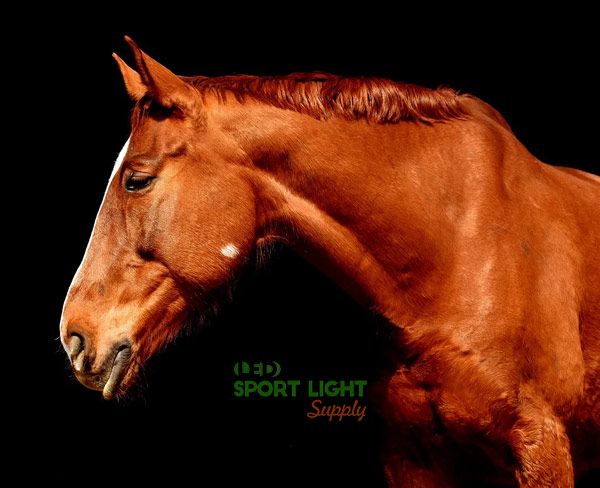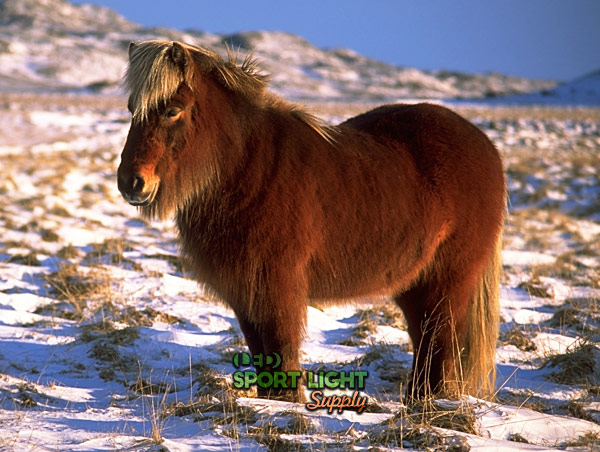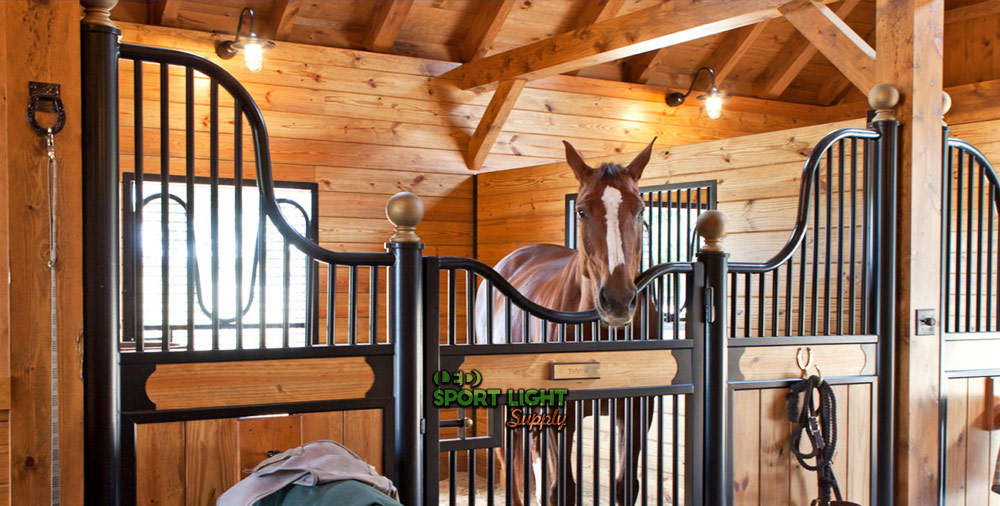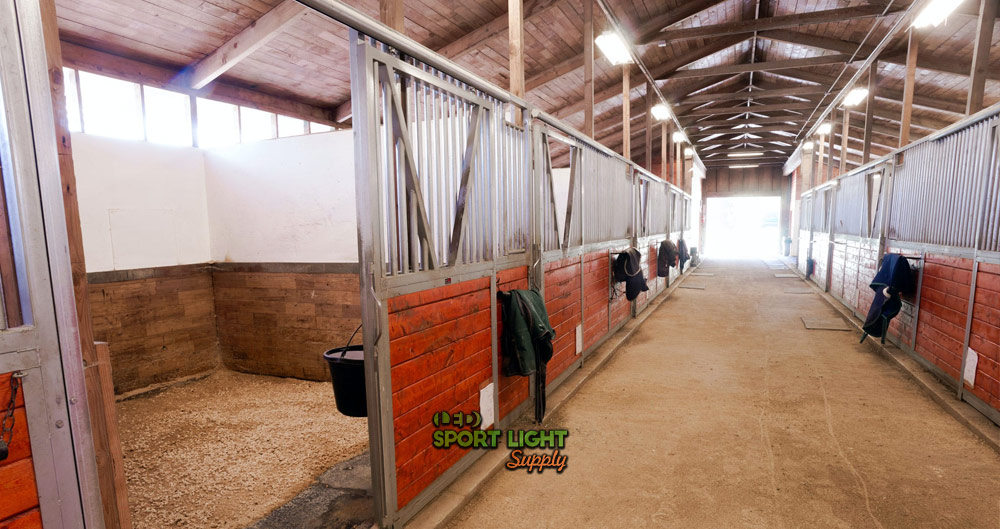Horses living in stables undergo various seasonal changes, and one factor that can negatively impact their health is the lighting within the stable. This, along with other factors like breeding, reproduction, and the development of seasonal coats, can directly influence a horse’s well-being. Understanding the importance of specialized stall lighting is crucial for enhancing your horse’s overall health.
Table of Contents
ToggleEffect of Lighting on Horse Health

The Impact of Arena Lighting on Horse Well-Being
Horses are naturally accustomed to receiving ample daylight to maintain their health, which is crucial for their overall well-being. However, the environment changes significantly when they move indoors, whether to a stable or a horse arena, where artificial lighting comes into play. While horses are less responsive to traditional incandescent lighting, advancements in LED technology have introduced lighting options that emit specific Kelvin wavelengths, catering more effectively to their needs.
Key Factors Influencing Horse Health Through Lighting
Lighting plays a crucial role in maintaining the regular health of horses by affecting various physiological processes. The following aspects illustrate how different lighting conditions impact horse health:
Sleep Environment
Horses thrive when sleeping in total darkness, which can be challenging in a stable setting with other returning horses. The ideal solution is the use of red light, which allows trainers to navigate the stable without disrupting the horses’ rest. Red light is particularly beneficial as it aids in the recovery process after training and promotes better sleep. Additionally, red light is essential for stimulating melatonin production, which is vital for healthy hair growth in horses.
Regulation of Internal Clock
Horses housed in stables can experience stress if the transition between lighting conditions is abrupt. LED lighting systems designed for equine environments can be programmed to simulate natural dawn and dusk transitions, reducing stress and helping horses adjust gradually to changes in light. This gradual change in lighting intensity also prepares horses for rest by slowly dimming into a red nighttime sleep mode.
Hormonal Changes During Training
Training horses experience various hormonal changes that can be influenced by light exposure. A crucial aspect of managing these changes involves using lighting that simulates daylight hours. LED lights enriched with blue wavelengths are beneficial during the day as they support the natural hormonal cycles of horses. At night, switching to red light helps to calm the horses and manage behavioral issues, ensuring a balanced approach to their training and overall health.
Lighting and Its Impact on a Horse’s Winter Coat Growth

Influence of Lighting on Seasonal Hair Growth
The natural growth of a horse’s coat is primarily stimulated by the amount of daylight they receive throughout the year. However, controlling this natural cycle becomes challenging during winter, as daylight is significantly reduced compared to the longer days of summer and fall. To counter this, blue light can be used within stables during the reduced daylight hours, promoting good health and maintaining healthy eating habits. At night, red light plays a crucial role in stimulating serotonin, which supports the overall well-being of the horse.
Effects of Stable Lighting on Winter Coat Growth
Horses naturally begin to grow their winter coat in late fall. However, the use of indoor stable lights can disrupt this natural cycle by tricking the horse into thinking it’s still spring or summer, thus preventing the growth of a winter coat. As a result, horses may require blanketing when outside to compensate for the lack of a natural winter coat. For horses that are maintained for year-round activities, such as touring or competition, longer hours of daylight-mimicking stable lighting are required to keep their coat short.
It’s important to note that as long as horses receive at least 8 hours of sleep at night, their overall health will remain stable. This manipulation of light to stunt excess hair growth is particularly beneficial for horses in colder climates, where maintaining a short coat is desirable. In warmer regions, this practice may not be necessary, but it remains essential for those in areas with harsh winter conditions.
The Role of Lighting in Horse Reproduction
Impact of Natural vs. Artificial Lighting on Breeding
Natural daylight plays a significant role in the breeding cycle of horses. For equestrian owners aiming to breed champions, preplanning is crucial, especially for those attempting to breed mares earlier in the year when natural daylight is scarce. This period of the year typically goes against the natural mating habits of a mare, necessitating the use of long daylight therapy.
Long daylight therapy involves the use of LED horse lights to artificially extend daylight hours, helping stallions and mares reach peak hormone levels in preparation for springtime breeding. This therapy not only aids in successful breeding but also contributes to the development of healthier foals. Additionally, mares benefit from improved milk and colostrum production, enhancing the health of newborn foals.
Post-foaling recovery is also expedited with this lighting therapy, ensuring that mares are ready to breed again sooner. A scheduled 90-day long daylight therapy for pregnant mares is recommended to ensure optimal health outcomes. In contrast, regular incandescent lighting is less effective, leading to lower success rates in breeding, reduced libido in stallions, and decreased sperm concentration.
Advantages of Controlled LED Lighting for Reproduction
LED horse lights offer controlled lighting conditions that are more conducive to breeding, ensuring that horses reach and maintain peak levels for successful reproduction. This contrasts with the traditional use of incandescent or halogen lights, which lack the necessary UV light found in natural daylight. The absence of natural UV light in these artificial sources can lead to the need for additional hormone treatments by veterinarians, a practice that is less healthy and more unpredictable.
Artificial Lights vs. Natural Daylight Effects on Horses

Artificial lighting, including incandescent and halogen lights, fails to provide the natural UV light that horses experience in daylight. This deficiency can lead to various health issues, such as eating disorders, behavioral problems, and disrupted circadian rhythms. The reliance on artificial lighting often necessitates supplemental hormone treatments, which are not as beneficial as natural long daylight therapy using LED horse lights.
The introduction of LED lighting in stables significantly enhances the lighting environment for horses, ensuring they receive the appropriate light levels that mimic natural conditions. This is especially important for horses involved in arena competitions and breeding programs, where optimal health and performance are paramount. LED horse lights offer flexibility and portability, allowing owners to maintain consistent lighting conditions whether at home or traveling.
Horse Lighting Q&A
Do Horses Need Light at Night?
The need for light at night for horses varies based on the conditions within the stable. While most horses require total darkness to sleep effectively, others may be comfortable with some degree of light. In many stables, horses are kept in individual stalls, and the lighting must be carefully managed to ensure a balance between visibility and rest. The light should be dim enough to create an environment that simulates darkness, allowing horses to sleep undisturbed.
This scenario poses a challenge for horse owners who need to return horses to their stalls without waking those already asleep. To address this, many owners use specialized lights, such as red lights, which provide enough illumination for humans to navigate the stable while not disturbing the horses. Horses have limited perception of red light, making it nearly indistinguishable from darkness, which helps them sleep better. Additionally, red light has a calming effect that can facilitate faster sleep onset for horses.
Should Horses Be Kept Under Lights?

Stable lighting is essential for maintaining the health and well-being of horses, especially when considering their intended purpose. Horses need stable lights to regulate their internal biology, which follows a preset clock influenced by daylight exposure. For equestrian owners, a structured lighting schedule is crucial to manage breeding periods and prevent unwanted seasonal changes, such as winter coat growth.
Providing horses with lighting that mimics the daylight spectrums of spring and summer can prevent the growth of a winter coat, which is desirable for horses involved in year-round activities. This artificial control of daylight helps horses maintain their performance without the additional weight of a winter coat. Stable lights effectively simulate outdoor lighting conditions, ensuring a strict and consistent cycle that supports the horse’s overall health, recovery, and behavior management.
Older lighting systems that use incandescent bulbs have been found to be less effective compared to modern LED lights. LED lights are specifically designed to mimic natural sunlight, offering better results in maintaining the horses’ health and performance. For professional competition and equestrian events, upgrading to LED lighting is becoming increasingly essential.
Can Horses Sleep with the Lights On?
The ability of a horse to sleep with lights on depends on the intensity of the light within the stable. It is generally not recommended for horses to sleep in environments with high light levels, as they have an innate sense of when to be awake and when to sleep. If the lighting is too bright, horses may struggle to fall asleep, which can negatively impact their health.
To create a more suitable sleep environment, some owners opt to use low-wattage bulbs or dimmers to reduce the light intensity. Ideally, total darkness would be best for horses to sleep, but this can be impractical for owners who need to enter the stable. A compromise can be achieved by using dim lights or positioning lights in areas where they are not directly visible to the horses. Professionals often choose red lights, which allow horses to sleep naturally while still providing enough visibility for humans to move around the stable.
The advantage of using red light is that it enables owners to check on the horses without disturbing them, ensuring that they can sleep peacefully until the natural daylight returns.
Can Horses See in the Dark?
Horses have excellent night vision, which allows them to see well in low-light conditions, though not significantly better than humans. Their larger eyes enable them to gather more light, giving them an advantage in darker settings. Under a full moon, horses can see almost as well as they do during the day, making them adept at navigating in dimly lit environments.
However, horses may struggle to distinguish objects in complete darkness, which can pose a risk if they are walking on uneven terrain. The transition from daylight to total darkness can be particularly challenging for horses, as their eyes take longer to adjust to the sudden change in brightness levels. Nonetheless, horses that return to a familiar, dark stable during nighttime conditions can generally see well enough to navigate safely.
The ability of a horse to see in the dark is thus limited by the conditions around them, but with favorable lighting, they can move confidently even in low-light environments.
Do Horses Sleep at Night?
Horses typically sleep for 3-4 hours at night, as they do not require extended periods of sleep like humans do. Interestingly, horses have the ability to sleep while standing up, thanks to a mechanism called the “stay apparatus,” which locks their muscles and leg bones in place. This allows them to rest without lying down, a behavior that some people find surprising.
Horses can also sleep with their eyes open, and experienced equestrian owners can often tell when their horses are asleep based on their lack of movement. The amount of sleep a horse needs depends on factors such as their exercise regimen and overall health. In cases of sleep deprivation, horses can go without sleep for several days, which may indicate underlying mental health issues or discomfort. Eventually, a horse will decide to sleep as needed, and their sleep patterns are generally self-regulated based on their environment and routine.
Conclusion
By using carefully managed LED lighting, horse owners can simulate natural daylight conditions, promoting better health and performance while minimizing stress. Understanding the effects of light on horses allows owners to create an optimal environment that supports their horses’ needs, whether for breeding, competition, or general care.
